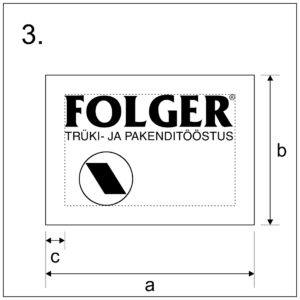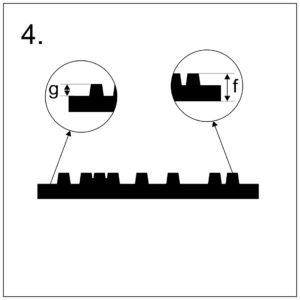Magnesium dies price list from 1 October 2009
Dies prices depend on the surface area of the die.
If the dies needs to meet special conditions or requires special processing, we will provide a separate quote before production.
| Thickness 2 mm | |||
| Standard | 0.7–0.8 | 5.50 | 0.11 |
| Deep | 1.2–1.4 | 5.80 | 0.12 |
| Riveted | 1.2–1.4 | 9.60 | 0.18 |
| Embossing | 0.3–0.5 | 5.50 | 0.11 |
| Embossing with special etching | 0.3–0.5 | 7.90 | 0.14 |
| Thickness 3 mm | |||
| Standard | 1.2–1.4 | 7.00 | 0.15 |
| Deep | 2.0–2.5 | 12.50 | 0.25 |
| Embossing | 0.5–0.7 | 7.50 | 0.20 |
| Thickness 7 mm | |||
| Standard | 1.2–1.4 | 8.50 | 0.45 |
| Medium | 2.0–2.5 | 15.40 | 0.79 |
| Deep | 3.0–3.5 | 18.00 | 0.95 |
| Polymer counter-plate for embossing die | 15.00 | 0.30 |
Delivery within Estonia:
► to parcel terminal – 3 euros
► Cargobus – 5 euros
Prices do not include VAT 20%.
Calculating the surface area of a die
Regardless of the image on the printing area of the die, the size of it will calculated based on the smallest rectangular area surrounding the image. Then a technological margin is added to this area on all sides (dimension c in figure 3).
Technological margin sizes:
► for 2 and 3 mm dies: 0.5 cm;
► for 7 mm dies: 1.0 cm;
► for embossing dies: 2.5 cm.
Desired die image.
Die’s printing area – d x e
Die’s surface area – a x b
technological margin – c
Die’s thickness – f
etching depth – g
The surface is calculated using the formula S = a x b,
where a = d + c + c and b = e + c + c
For example:
a) the surface area of a 2 mm die with a rectangular printing area with a width of 9 cm and a height of 7 cm is (9 + 0.5 + 0.5) x (7 + 0.5 + 0.5) = 80.0 cm²;
b) the surface area of a 3 mm embossing die with a circular printing area with a diameter of 11.5 cm is (11.5 + 2.5 + 2.5) x (11.5 + 2.5 + 2.5) = 272.25 cm²;
c) the surface area of a 7 mm die with a polygonal printing area with a maximum width of 18 cm and a maximum height of 6.5 cm is (18 + 1.0 + 1.0) x (6.5 + 1.0 + 1.0) = 170.0 cm².
Need advice or a price quote? Get in touch!






